Recent Storm Damage Posts
What should a homeowner do if their Plymouth home is ever damaged by floods?
6/6/2022 (Permalink)
If Floods Ever Impact Your Plymouth Home, You Should First Contact a Good Local Flood Damage Cleanup and Remediation Service for Help.
Every year, powerful seasonal storms batter Plymouth and the rest of the Northeast. These monstrous weather systems often bring with them intense winds, torrential rains, flooding, and massive headaches for area homeowners. As the storms pass through our community, your home could be compromised in a myriad of ways. Tree limbs, or even entire trees, could fall on your house, damaging roofing and windows. This, in turn, could make your residence much more vulnerable to stormwaters. At the same time, flying debris could further impact your home in such ways and block its drainage systems. Then, as heavy rains swell local rivers, lakes, and ponds, your house could be put in the direct path of raging floodwaters.
What Makes Flood Waters Particularly Hazardous?
Flood damage remediation in Plymouth involves much more than simply removing the floodwaters and airing-out a residence. As SERVPRO, a local Plymouth flood damage cleanup and restoration company, understands, it takes much more than this. This is because floodwater, classified as “black water,” is the most contaminated type of water you can encounter. It flows over various polluted surfaces, carrying with it such things as:
- Human corpses and animal carcasses
- Animal and human feces
- Industrial wastes
- Toxic chemicals
- Other harmful substances in soils
This contaminated water is teaming with troublesome microorganisms that could, if not quickly and successfully eliminated, irreparably impact your residence and cause health effects.
How Does SERVPRO Quickly and Effectively Clean Up Flood Damage?
As your neighborhood SERVPRO, we are located nearby and our skilled technicians live in your community. This is why we can often be onsite to help resolve your Plymouth flooding issue within four hours of your call, twenty-four hours a day, 365 days a year. Once at your residence, SERVPRO experts:
- Inspect your home, noting all water damage and potential safety concerns like the presence of lead or asbestos
- Rapidly extract gallons of polluted standing floodwaters from your house with industrial strength extractors and submersible pumps
- Disinfect surfaces around your home with EPA-approved disinfectants and high-tech foggers
- Professionally dispose of hazardous wastes
- Set a drying goal based on local conditions and monitor its progress with moisture sensors/meters and thermohydrometers
- Quickly dry the interior of your residence with a network of cutting edge air movers, dehumidifiers, and Injectidry systems
- Further disinfect and deodorize your house with advanced antimicrobial-delivering foggers
Taken together, all of these measures help ensure that your flood damage is remediated as quickly and effectively as possible. Many times, they can save you from future issues related to a flooding event, which can save you precious time and money.
How Do SERVPRO’s Foggers Disinfect Surfaces and Neutralize Odors?
The greatest concerns related to flood damage cleanup are eliminating harmful microbes and neutralizing unpleasant odors. In order to tackle these key problems, SERVPRO employs the most advanced foggers in the industry today. Our thermal foggers create dense fogs filled with disinfectants/deodorants that eliminate microbes or unwanted smells from confined areas of your residence. Technicians use ultra-low volume (ULV) foggers that aerosolize microorganism/odor-eliminating agents to treat impacted materials and difficult-to-access parts of your home. This is possible because ULV foggers, unlike other foggers, create fine mists that are able to easily penetrate tight areas and the small pores of affected materials.
What Can Happen to My Home If I Don’t Have It Properly Cleaned by Knowledgeable Professionals?
As previously explained, floodwaters are particularly dangerous because they usually carry numerous harmful microorganisms. The harm that these microscopic threats often cause is in addition to the troubles generally associated with regular water damage. Some examples of the issues you can eventually expect to encounter after having ineffective remediation service performed are:
- Persistent foul odors that may become more pronounced during hotter and more humid periods
- Discolorations and stains from proliferating mold and mildew on floors, walls, and ceilings
- Deteriorating drywall and plaster
- Warping and buckling of floors, walls, and ceilings
- Structure-destroying dry rot that could require substantial and costly reconstruction efforts
It is for all of these reasons that you should take care of any flood damage as soon as possible and have the work done by trained professionals. Otherwise, over the long term, your delays could cost you dearly.
As caring members of your community, we urge you to always prepare for storms and related flooding. Also, you should know your cleaning and restoration options well before storms arrive. With all that said, if you ever need help cleaning up in the aftermath of flooding, call SERVPRO of Plymouth/Wareham at (508) 746-9500 for assistance.
How quickly can my home get dried out after a flood?
6/6/2022 (Permalink)
For Fast, Professional Restoration in Your Plymouth Home, Call SERVPRO
Stormwater is a greater threat to area homes than what flows from a broken pipe or split hose. Even if the same amount of water hits the floor, outside water picks up a small amount of everything it crossed before entering your home. Removing the dirt, grass, and other debris takes additional time to return each home to a clean, safe condition.
How Long Does Everything Take?
That depends on how much water is present, and the size of your home in Plymouth. Flood damage restoration also only starts with removing the water. SERVPRO technicians use pumps and extractors that draw out most of the small bits of contaminants along with the flooding, but getting out the larger debris still requires removing it by hand and shovel.
Can Everything Be Salvaged?
Almost. Carpets simply absorb too much water and contaminants to safely use again, so our team members throw them out immediately after removing the water. Paper and cardboard turn to mush in minutes, so it goes out by the shovelful as well. Nearly everything else we can save with a combination of commercial-grade cleaning agents and restoration equipment.
What about Drying Out My Home, So It Doesn’t Smell?
SERVPRO technicians use air movers, dehumidifiers, and exhaust fans to draw out remaining moisture trapped in both the structure of your home and personal property. Besides preserving the material, these actions also help remove any musty odors left behind. In addition to our cleaning agents, technicians also have access to chemicals and tools that can cover up any malodors until they fade or eliminate them, even if they penetrated wall framing and other support structures.
Regardless of how much water entered your home here, contact SERVPRO of Plymouth/Wareham today at (508) 746-9500. We are ready to help you return home as quickly as possible.
SERVPRO can extract the water and dry your basement quickly
3/14/2022 (Permalink)
SERVPRO can extract the water and dry your basement quickly
When floodwater enters a basement, it is vital to get the water out of the area as fast as possible. This is particularly true for basements as many do not have sump pumps or enough drainage. The longer the water stands, the more it degrades, and the more dangerous it becomes to handle due to bacteria and other harmful elements.
Why Should I Outsource the Cleanup of Flood Damage to My Basement?
SERVPRO technicians take special care to remove the flood damage in Plymouth area homes. Common issues homeowners deal with when this type of water loss happens can include:
• The flooring of all types tends to take a beating and often requires removal to dry the concrete substrate underneath
• Wet contents that require relocation to another area for drying
• Standing water
• Damaged sheetrock in finished basements
How the Professional Extraction and Drying Process Works
The techs test the water so they can identify any harmful elements they are dealing with. SERVPRO technicians use portable pumps most often unless the water is greater than two inches in depth. In those cases, submersible units can get the job done rapidly. Most flooring requires removal and disposal, exposing the substrate for drying. Because most basements do not have the same ventilation as the rest of a home, the drying process can need a large number of air movers and multiple dehumidifiers to rapidly reduce the interior humidity levels.
Final Cleaning for a Complete Restoration
After the drying phase completed, the techs wipe down the water loss area with antimicrobials or antibacterial cleaning agents as needed. This leaves surfaces sanitized and ready for reuse by the residents.
When intense storms deliver flood damage to local properties, the certified technicians at SERVPRO of Plymouth/Wareham at (508) 746-9500 are ready to come to your residence 24/7 and make the water loss “Like it never even happened.”
Are you storm ready?
3/9/2022 (Permalink)
Are you Storm Aware?
As we continue to see storms throughout our Plymouth and Wareham area cities, we at SERVPRO want you to be aware of what the different threat levels mean so that you can be better prepared for whatever happens.
Flash Flood Watch
A Flash Flood Watch is issued when conditions are favorable for flash flooding. It does not mean that flash flooding will occur, but it is possible.
Flash Flood Warning
A Flash Flood Warning is issued when flash flooding is imminent or occurring.
Flood Watch
A Flood Watch is issued when conditions are favorable for flooding. It does not mean flooding will occur, but it is possible.
Flood Warning
A Flood Warning is issued when flooding is imminent or occurring.
If your home or commercial building ever suffers flood damage, call the SERVPRO® of Plymouth/Wareham experts.
Storm tips and tricks
3/9/2022 (Permalink)
What to Do After a Severe Storm Hits Your Property
In New England, the northeaster storms are a recurring event which leave behind a devastating damage. This includes property damage on both commercial and residential properties of residents in the Greater Plymouth County Area including Plymouth and Wareham, MA. SERVPRO of Plymouth/Wareham, with its disaster team, is always ready to help you out with any and all kinds of storm damage restoration. Our team of professional, skilled and competent crew is trained to handle your property proficiently and deliver the best and desired results to you. We understand that storm damage can become a cause for water, mold and even fire damage. Don’t worry, we offer all the services needed to recover under our company’s umbrella and we’re ready to restore your property so effectively that the damage will seem "Like it never even happened."
Here’s a list of useful tips for properly inspecting and restoring storm damage at your house or commercial premises:
Useful Tips on Inspection and Immediate Restoration
First and foremost, keep in mind that if you have been evacuated don’t take the chance and stay at your property to handle protecting efforts on your own during the storm. Always wait for the official authorities’ clearance call before getting out of your safety area. Once you have the green signal, only then invest your time and effort in inspecting and making initial restoration. We advise that you call SERVPRO of Plymouth/Wareham before taking any action. Our professionals will guide you through what needs to be done till they reach your property.
Here’s a list of things you can do:
- Carefully inspect the house/office all over. Visit every corner of the property. Note down the intensity of damage. You may also take pictures to use for insurance. But keep in mind that you should steer clear of any and all areas that seem unsafe in any aspect.
- Do not walk into rooms or spaces that may have exposed electrical wiring, especially if that area is flooded with water. Ensure that you’ve switched off the electricity from the main switch before walking into your property. Do not walk into dark areas without proper lighting.
- Do not touch, move or remove heavy items such as floored carpets, sofas, armchairs, furniture, appliances, etc. Most of these will pose a safety threat because of being extremely heavy due to water absorption. Do not touch any electrical appliances.
- Take pictures of damaged and affected areas from a safe distance. Do not walk into, under, onto, or over dangerous spaces such as stairs, attics, basements, balconies, etc. Any place that creaks noisily has to be avoided at all costs as it may cause physical damage to you.
- You may however bring out small items such as valuables, pieces of art, expensive decorative items, etc. into an open dry space and let the excess water evaporate under the sun. This will help in the water damage restoration process of our professional crew.
- For books, magazines, etc., it is better to let them stay where they are if they are inside shelves, cabinets, desks, etc. If you pull them out, it may distort and damage the books. However, ensure that you pull out valuable documents and keep them dry and safe.
- Do not try to work on the plumbing, heating, cooling, ventilation and electrical network within your home. What you’re about to do may seem like a small act in your favor, but it may become the cause of damaging your property on a large scale, not to mention the safety risks involved.
- Once you have taken care of everything that you can do, wait for our professional crew to show up. Let them do their job and with your coordination and cooperation, they will restore your property back to its former glory. We always deliver the best solutions and results to our clients.
- Storms can even cause fires which means that you will have to look into fire and smoke damage restoration Avoid using candles if possible. We advise that you stay away from open circuits, electrical wires, switches, plugs and the likes. It is never safe to handle such situations on your own.
- If the water from the storm is left to sink in, it will eventually lead to mold growth. Mold damage restoration by our experienced crew will ensure that all sources of excess water are repaired so as to lower the unwanted moisture content back to normal levels.
Always remember that professionals who have been effectively dealing with storm damage of all shapes and sizes for years will definitely know how to handle it more efficiently than inexperienced and unskilled crew. So always invest your money and time in leading companies that have years of experience, such as SERVPRO of Plymouth/Wareham.
For further queries, call us at (508) 746-9500.
Storm Professionals
3/1/2022 (Permalink)
Storms occur with little warning and can be especially devastating, so you’ll need the company that you can trust to rise to the occasion. Regardless of the type of storm, SERVPRO of Plymouth/Wareham can handle any size disaster.
SERVPRO of Plymouth/Wareham is strategically positioned to be faster to any size emergency.
An immediate response helps to minimize the damage and the cleaning and restoration costs.
Water is particularly invasive, quickly spreading throughout your property and being absorbed into floors, walls, furniture, etc. We arrive quickly and start the water extraction process almost immediately.
Flooding and water emergencies don’t wait for regular business hours and neither do we. Emergency water restoration services 24 hours a day, 7 days a week—including all holidays. You can expect an immediate response time, day or night.
In the event of a storm damage occurrence, please call us and we will be there with the help you need, 24/7/
508-746-9500
Floods
1/26/2021 (Permalink)
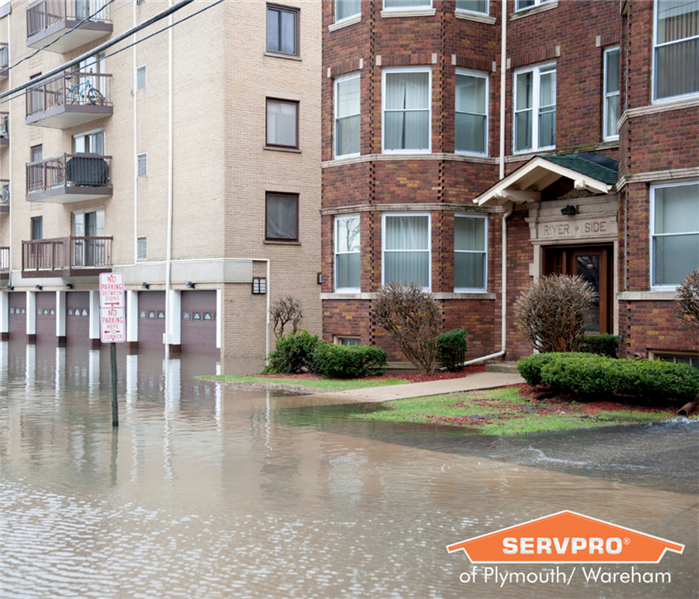 If you haven’t been affected by floods, it doesn’t mean you won’t be affected in the future. Make sure you are prepared!
If you haven’t been affected by floods, it doesn’t mean you won’t be affected in the future. Make sure you are prepared!
According to the National Weather Service (NOAA), “Approximately 75% of all Presidential disaster declarations are associated with flooding.” This isn’t just hurricanes, but includes a long list of water related natural hazards such as,
• Flash Flooding
• River Flooding
• Storm Surge and Coastal Inundation from Tropical and Non-Tropical Systems
• Ice/Debris Jams from Nor’easters and other winter storms
• Snowmelt from quickly changing temperatures after large storms
• Dry Wash which is caused by heavy precipitation in typically dry regions
• Dam Breaks/Levee Failure especially in low lying areas around these dams and levees.
If you haven’t been affected by floods, it doesn’t mean you won’t be affected in the future. In fact, close to 1 in 5 claims paid by the National Flood Insurance Program (NFIP) came from low-risk communities. Floods can cause extensive damage, and we’ve seen it first hand on many different levels. Our SERVPRO of Plymouth/Wareham storm team dispatched to 4 storms within the last few years. Hurricane Harvey was an especially long dispatch, but it gave our technicians priceless hands-on experience. We haven’t seen a big storm in the South Shore area in a while, and we hope the weather stays mild. If there ever where to be a storm that caused flood damage to your home or business, we are always Here to Help.
Even when it comes to damage caused by common weather conditions like rain or snow, we are here. Big or small, we are faster to any sized disaster. We can also assist you with preventative measures, like with our Emergency Ready Profile® (ERP) which is geared towards helping businesses with incident response and disaster recovery plans.
Our technicians are on call 24/7/365 and every time you call you speak to a SERVPRO of Plymouth/Wareham employee. No time wasted speaking to a calling center waiting for a call back. We are ready and trained to respond to any problem, no matter the size, and help you pick up the pieces. Our restoration and cleanup services will allow you to get your life back on track quickly and efficiently.
It's Frozen Pipe Season
1/26/2021 (Permalink)
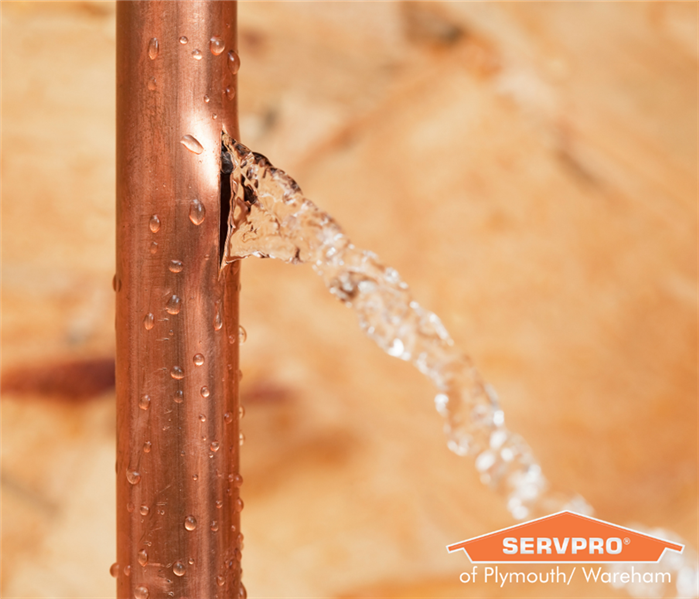 If you have water damage from a burst pipe, call SERVPRO of Plymouth/Wareham at 508-746-9500
If you have water damage from a burst pipe, call SERVPRO of Plymouth/Wareham at 508-746-9500
Winter is a precarious time of year but not only for you but also for your pipes, so make sure they are taken care of this winter as they are very susceptible to be frozen over. This can happen in a number of ways.
- Temperature. Pipes freeze at temperatures of 20 degrees Fahrenheit or less so make sure to watch the thermostat!
- Lack of Running Water, if there has not been a lot of water movement or movement through the pipes they can freeze over so make sure to drip some water from your taps from time to time if it is especially cold out.
- Failure to drain all outdoor water lines prior to winter, such as sprinkler systems and swimming pool lines.
If your pipes do freeze, there are several methods to help thaw them out. Some examples include using:
- Hot Towels. A hot towel placed over the frozen pipe is one of the most effective ways to thaw out the pipe in a safe way.
- Hairdryer. If you don’t want to go through the hassle of heating up a towel, however, a hairdryer works perfectly! Just be prepared to be there for a little while.
- Heat Lamp, if you are using this method make sure to comply with all safety instructions on the product and place it in a spot where the heat can easily reach the frozen pipe.
If you do fall victim to frozen pipes that end up leading to water damage, give us a call. Our trained technicians can help restore your home or business back to it's pre-water damaged condition.
7 Preparedness Tips for Your Pets
9/24/2020 (Permalink)
 Your pets are family too, prepare for them as such.
Your pets are family too, prepare for them as such.
National Preparedness Month; Preparing for your Pets
September is National Preparedness month. Since 2004, this month has been a time to remind Americans of the importance of preparing for natural disasters, large scale catastrophes and other unexpected events. The event is sponsored by the Federal Emergency Management Agency (FEMA) and was a response to a recognized need for individual responsibility and action in the case of unforeseen emergencies. The agency shares best practices for individuals, families and businesses in advance of possible disasters. These include how to build an emergency preparedness kit, awareness of nearby emergency shelters and how to prepare youth for emergency situations.
Particularly pertinent, and often overlooked, are emergency preparedness tips for one’s pets. As a general rule FEMA advises that “what’s good for you is good for your pets.” Emergency preparedness for pets includes ensuring that an emergency kit is prepared for the pet, that pet evacuation measures are planned in advance and that the pet is easily identifiable in case they are lost or injured. The agency also recommends compiling a list of facilities for the safe housing of pets that cannot be evacuated along with the family. The pet is ultimately the responsibility of its owner and must be included in family emergency planning as any other family member would be. Special considerations are made for large animals such as horses and livestock, as well as animals that have specific needs.
7 Emergency Preparedness Tips for Your Pets
- As a general rule what’s good for you is good for your pets. Plan for your pet as you would any member of your family
- Arrange for a neighbor or a trusted friend to check on your pet in the case that you are unable to do so yourself
- Prepare an emergency kit for your pet that includes food, medications, a list of nearby pet hotels, and other essentials
- Have your pet micro-chipped
- Keep an up to date list of your patient’s medical records as a kennel or boarding facility will typically require this to make sure your pet’s vaccinations are up to date
- Do not chain or restrain your pets outside during a natural disaster
- Ensure that all animals have some form of identification
Your pets are like family, and you should prepare for them as such. If you follow some of these pet emergency preparedness tips, you will be well on your way! If a fire emergency does happen in your home, call us at 508-746-9500
National Preparedness Month
9/17/2020 (Permalink)
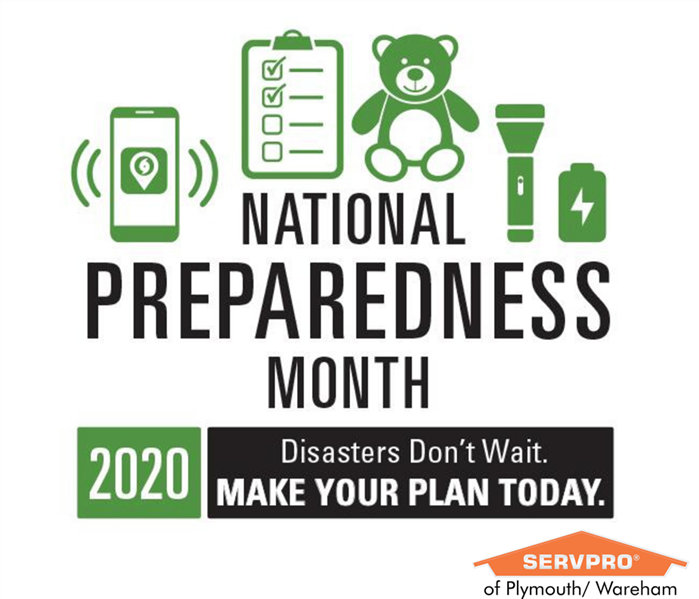 Contact us for a complimentary Emergency READY Profile for your business or commercial property! As always, stay prepared!
Contact us for a complimentary Emergency READY Profile for your business or commercial property! As always, stay prepared!
It's National Preparedness Month
Did you know that September is National Preparedness Month? It is recognized each September to promote community and family disaster planning. This year’s theme from ready.gov is “Disaster’s Don’t Wait. Make Your Plan Today.” Let’s look at some ways you can start planning today.
In Your Home:
- Install storm shutters ahead of time to protect windows—temporary board ups with plywood work in a pinch.
- Bring valuable items upstairs for protection.
- During a severe storm, remember to take shelter in a lower-level room away from any windows or doors.
- If power is lost, unplug electrical devices and appliances to prevent a power surge once the electricity is restored.
- Turn your refrigerator and freezer to the coldest setting In case of power loss. Do not eat food that has warmed past 40° F.
- Lightning can actually travel through metal pipes and shock on contact- so hold off on the shower if you hear thunder.
At Your Commercial Property:
- If instructed to do so- turn off all utilities (electric and gas) at the main switches or valves when instructed to do so.
- Disconnect all electrical equipment, devices and appliances.
- Raise elevators (if you have them) up from the bottom floor if a major storm is approaching.
- Board up windows prior to forecasted storm events, such as hurricanes or snow storms.
- Make sure your server is backed up and safely stored in another location.
- Make sure you have a plan in place for employee safety that includes accounting for all, and designating emergency meeting areas.
- Contact SERVPRO of Plymouth/Wareham to set up an Emergency Response Profile (ERP), which focuses on incident response and disaster recovery.
If storm damage impacts your home or business, call us at SERVPRO of Plymouth/Wareham, 508-746-9500. Our trained technicians can help bring your home back to it’s pre-damaged condition.
To learn more about preparedness, go to www.ready.gov/september
The Different Types of Storms
1/3/2020 (Permalink)
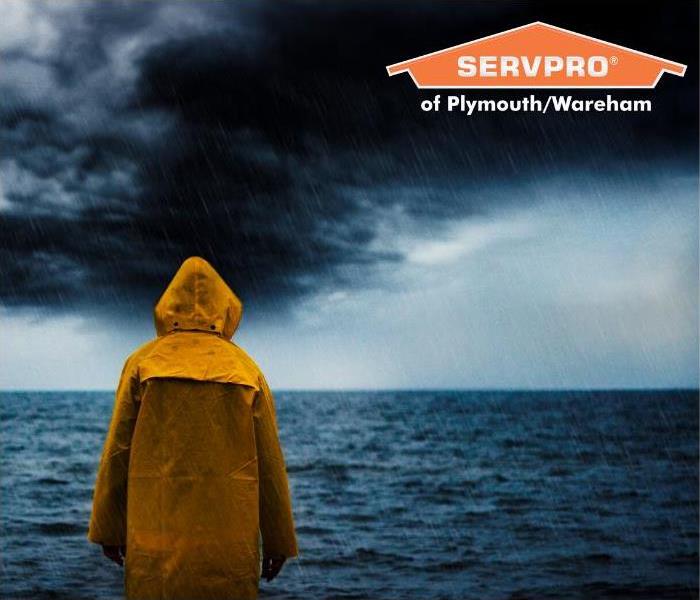 Know your storms!
Know your storms!
Hurricanes, Blizzards, Nor’easters and Microbursts
Although most people experience a range of storms during the winter season, most remain unclear on the differences between hurricanes, blizzards, nor’easters, and microbursts. First, let’s examine hurricanes, also called tropical cyclones. They form over large bodies of water, and involve rising hot air (from the ocean), and sinking cool air (from higher up in the atmosphere). Hurricanes affect large areas and feature strong winds, thunderstorms, and heavy rainfall. A blizzard, on the other hand, is a much more localized storm and features heavy snowfall accompanied by high winds. Blizzards do not last as long as hurricanes, and generally dissipate within a single day. Nor’easters are a specific type of blizzard, which develops along the New England and eastern Canada coasts.
A Nor’easter is much larger than a typical blizzard, and also features some hurricane-like traits, namely the formation of a low-pressure area off the coast, which pushes strong winds from the northeast, often causing havoc on the coast. Finally, microbursts are localized thunderstorms that are caused by a downward motion of air within a thunder cloud. They are short-lasting and can often be destructive. All of these types of storms can cause severe damage to both residential and commercial buildings, however, the ferocity and speed of winds are highest in the case of hurricanes (depending on intensity) and microbursts. On the other hand, nor’easters can be extremely damaging to the coastline, and heavy blizzards can often dump enough snow to collapse roofs and bring down trees.
When a storm strikes the Plymouth Area, and your home or business suffers storm damage- leave it to the professionals. Call SERVPRO of Plymouth/Wareham at (508) 746-9500
Ice Dams
12/31/2019 (Permalink)
 Know the signs of an ice dam.
Know the signs of an ice dam.
Explaining Ice Dams
In much of the country, winter weather comes with myriad hazards. Ice is usually the most dangerous of these seasonal threats. That’s when ice dams can come in to play.
An ice dam is a ridge of ice that forms along the edge of a roof and prevents melting snow from draining off. The heat inside the home then melts a large amount of snow turning it to water, but that water cannot drain off the roof because at the very edge of the roof is hardened snow and ice (which cannot be reached by the heat inside). This results in the pooling of water, which then seeps into the roof and walls causing interior water damage.
The pooled water can also promote the growth of mildew and mold since it is usually the attic that gets the moisture from the ice dams, and attics are often perfect breeding grounds for mold. The best way to deal with ice dams is to prevent them from happening. You can do this by ensuring proper insulation. This will allow less heat to escape into an attic and prevent melting the snow on the roof. Otherwise, the best short-term action that can be taken is simply removing snow that accumulates on the roof, especially at the edges- but do so carefully.
If your home falls victim to an ice dam and there’s water damage involved- call SERVPRO of Plymouth/Wareham. Our trained technicians have the experience and expertise to return your Plymouth home back to its pre-water damaged condition.
Why You Should Always Thoroughly Clear All Snow From Your Vehicle
12/30/2019 (Permalink)
 Remember, you can be fined up to $200 if pulled over for failure to clear snow and ice off your vehicle properly.
Remember, you can be fined up to $200 if pulled over for failure to clear snow and ice off your vehicle properly.
Clear the snow, or face the consequences
In our safety-valued society, it is strange to see so many people driving around with piles of snow on the roofs of their cars. The danger posed by these uncleared piles is clear for everyone to see. As cars speed up, especially on highways, the backdraft blows the snow and hardened ice into the windshields of following vehicles, momentarily blinding them, or possible damaging their cars.
Added to this are precarious road conditions – usually, when it snows, the road is slippery, wet, or possibly even icy. On January 30, 2019, after a particularly bad storm, Massachusetts State Police issued a warning to drivers that they could be fined up to $200 if pulled over for failure to clean their cars properly. This came after an incident in Boxboro when chunks of ice blew back from a tractor and smashed into a car’s windshield. Another car was struck by flying snow and ice in Auburn, on January 22 of that year. Ultimately, the dangers are clear to see, and responsible drivers have a moral obligation to ensure they are not a threat to others on the road.
Though completely clearing the snow off your car might feel like a tedious task, remember that it’s about safety. Don’t cut corners either, you can be fined up to $40 for unsafe operation if the snow is blocking any of your visibility. So please, the next time it snows please make time to completely and properly clean your vehicle of all snow and ice. It could save a life.
Nor’Easters
12/27/2019 (Permalink)
 If a Nor'Easter like this hits the Plymouth, Carver, Wareham & Kingston areas- remember that SERVPRO of Plymouth/Wareham is always Here to Help!
If a Nor'Easter like this hits the Plymouth, Carver, Wareham & Kingston areas- remember that SERVPRO of Plymouth/Wareham is always Here to Help!
What are they?
Nor’easters are storms that frequently strike the northeastern region of the United States. We’ve seen quite a few here in Plymouth in our lifetimes, and we are no strangers to the Nor’easter. While they can occur during any month of the year, with the most powerful occurring between September and April. They typically cause significant economic damage, stemming from transportation interruptions due to precipitation, wind damage, and flooding. These storms typically develop between Georgia and New Jersey and particularly strong in the New England and Southern Canada regions. Cities such as Washington, New York, and Boston are commonly affected by their heavy snowfall and gale-force winds, and coastal regions are subject to flooding.
Nor’easters are relatively common storms and a warning can be provided days in advance of their arrival. As such, they are not challenging to prepare for, unlike more extreme storms. Meteorologists monitor conditions that could be conducive to the formation of these systems, particularly in the fall and winter months, and issue watches and warnings to local populations as they see fit. When a storm does strike, it is on the individual to prepare themselves.
However, especially for a resident of Plymouth, these are not uncommon occurrences and are not too challenging to prepare for. The most dangerous aspect of most storms is the harsh conditions, and as such households should stock up on foods and drinks, particularly non-perishable items in case of a power outage. In this instance, a family should also have a plan to provide heating for potentially days if the power goes out. Coastal residences may consider evacuating to a more inland location, as floods are possible. Once the storm begins, it is best to stay inside, as driving conditions, in particular, will be very dangerous with low visibility and ice on the roads. Once the storm passes, usually in a day or so, households should be prepared to shovel out driveways and sidewalks. Beyond this, nor’easters are relatively straight forward storms to prepare for and, outside of the strongest, are not typically as catastrophic as a hurricane or other natural disaster may be. However, preparation is key. If a Nor’easter does strike and your Plymouth home is left with storm damage- SERVPRO of Plymouth/Wareham is here to help. We can help make your storm damage “Like it never even happened”
What to Avoid After Flood Damage in Plymouth Homes
12/8/2019 (Permalink)
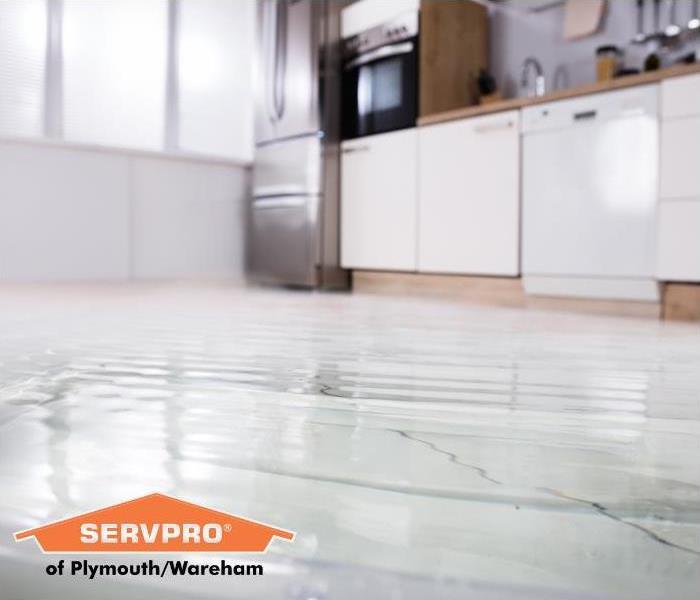 Don't risk flood waters causing extensive structural and content damage in your home. Call SERVPRO right away after your home experiences flooding.
Don't risk flood waters causing extensive structural and content damage in your home. Call SERVPRO right away after your home experiences flooding.
Understanding Contamination Risk After Plymouth Flood Damage
Homeowners in Plymouth experiencing overland flooding after heavy precipitation or storm surge have a severe problem brewing in their cellars or lower living levels. If you believe biohazards are something that exists only in healthcare, trauma, or industrial settings, think again. Flood waters can contain a vast range of highly infectious and dangerous substances, flowing without discrimination into your home after a storm or major sanitary sewer system backup.
Specialized Equipment and Training Essential to Manage Flooding
Flood damage in your Plymouth home must be mitigated and remediated using appropriate safeguards from the start. Our crews wear personal protective equipment (PPE), beginning with assessment activity. The waters invading your home can contain various biohazards, requiring the use of PPE. Methane and other vapors harmful to breathe are often present, requiring the use of respirators. Although the flood waters can look relatively clean, assume they contain biohazards, many of which are visible only when viewed through a microscope.
Air Scrubbing Technology
Although SERVPRO’s focus is on removing the flood waters and drying the structure, we take the time to set up containment systems first. Expect us to partition off the affected area using heavy plastic, running air scrubbers to seal the perimeter and force the atmosphere inside through HEPA filters before venting outside. Pathogens can be ingested or pass through unprotected skin, and also can infect through the human respiratory system. Air scrubbers also help reduce the odors that can linger by removing the invisible particles stirred up during the restoration process.
Mold Growth Risk Increases After Flood Damage
The flood waters might contain some additional fungi, but mold spores are already in your home, awaiting a source of moisture to begin their life cycle. SERVPRO understands how critical fast flood water removal and drying is to limit potential mold growth. The window of opportunity for an explosion of mold damage can be as short as 24 to 48 hours after the flooding.
Contact SERVPRO of Plymouth / Wareham at (508) 746-9500 immediately after flood waters enter your home. The risk of illness and structural damage following sewer backups or overland floods is significant without professional intervention.
Click here for more information about Plymouth.
Cleaning Up After Plymouth Home Flood Extraction
11/25/2019 (Permalink)
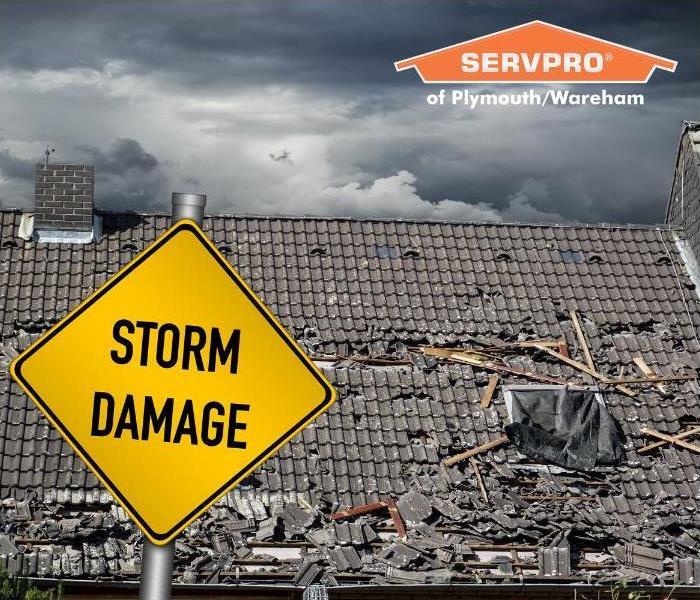 Plymouth residents never fear, SERVPRO is here for your Plymouth storm damage.
Plymouth residents never fear, SERVPRO is here for your Plymouth storm damage.
Storm damage can get out of hand, let SERVPRO help your Plymouth home get back on top.
Extraction is always one of the first tasks that must occur when flooding has damaged your Plymouth home. The faster that our professionals can reduce standing water and begin drying the property, the less installed structural elements that risk overexposure and deterioration. Our professionals must implement premier cleaning practices using potent disinfectant products to bring your property back to preloss condition to truly make flood losses “Like it never even happened.”
There are many steps involved in the management and restoration of flood damage to Plymouth properties. However, the post-extraction cleaning and cleanup after necessary reconstruction are vital to the finished product. Debris can exist from the path that flooding took into your home, even if it is a clear water incident. Insulation, deteriorated drywall and ceiling tile, and dirt are all components of residue and remnants our SERVPRO team must address after flooding.
Preparing your property for this cleaning phase often begins with practical extraction efforts. With the presence of solids or debris in the standing water, our professionals must use more powerful extractors with larger intake and discharge hoses like our self-priming trash pumps. For clean water incidents, the preferred extraction tool for even widespread floodwater is the electric submersible pump. This machine provides a steady, quiet removal of water until the affected area is less than 2 inches in depth.
Debris removal can happen in the early stages of flood mitigation and following controlled demolition/build back through a trusted, reputable contractor. Removing residues from surfaces requires the use of one of many disinfectants and cleaning agents available through our SERVPRO line of products. Some of these products help to provide a polished finish on the affected surface, such as our revitalizing cleaning compound for hardwood floors that leaves a slight sheen finish.
No matter how widespread or severe flood loss effects can be after a disaster, our SERVPRO of Plymouth / Wareham professionals can help with a fast response as well as premier restoration and cleaning practices. No matter how we can help, you can reach us 24/7 at (508) 746-9500.
To learn more about Plymouth, click here.
Hurricane Florence
9/13/2018 (Permalink)
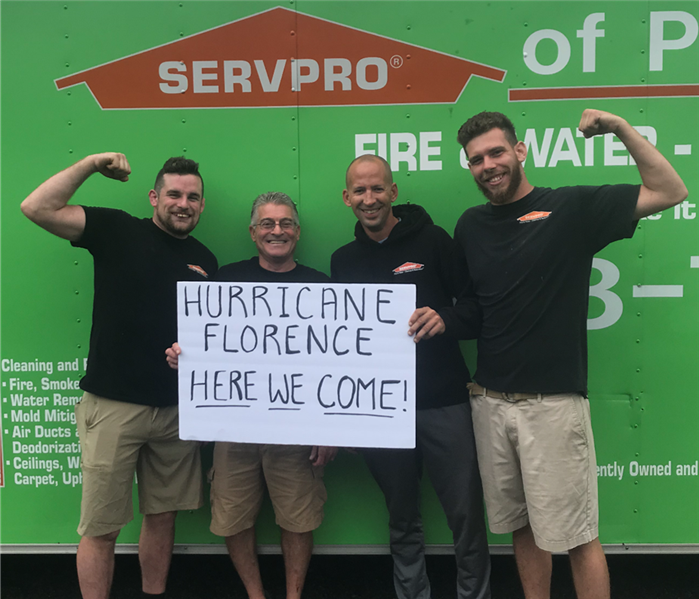 SERVPRO of Plymouth / Wareham crew members preparing to dispatch for a Storm Event following Hurricane Florence.
SERVPRO of Plymouth / Wareham crew members preparing to dispatch for a Storm Event following Hurricane Florence.
SERVPRO of Plymouth/Wareham heads to the Carolinas in preparation for Hurricane Florence
One of our crews here at SERVPRO of Plymouth/Wareham packed up early this morning to head down to the Carolinas in preparation for Hurricane Florence. The storm crew consisted of a Production Manager, a Crew Chief, and two highly skilled technicians. SERVPRO of Plymouth/Wareham has been to several “Storm Events” within the last few months, but this one is anticipated to be the most catastrophic. The crew packed up 3 SERVPRO vans and a 26-foot trailer full of generators, air movers, dehumidifiers, sub pumps, and various other necessary equipment needed to help restore damage the impending hurricane is expected to cause.
By late this evening, the Carolina coasts can expect strong winds over 80 MPH. What will be most dangerous to the Carolina residents are the storm surges. A storm surge is a coastal flood or tsunami-like phenomenon of rising water, and Hurricane Florence will be causing storm surges as high as 9 to 13 feet. According to North Carolina Gov. Roy Cooper, “Tens of thousands of structures are expected to be flooded, and many more by rising rivers and creeks.”
Hurricane Florence is expected to hover over the Carolinas, dumping persistent rainfall and hurricane-force winds until Saturday. Florence is expected to unload approximately 10 trillion gallons of rainfall in North Carolina by the time it passes. Its center will approach the North and South Carolina coasts later tonight as well as Friday. The actual landfall will be Friday afternoon at the earliest according to Neil Jacobs of the National Oceanic and Atmospheric Administration.
Over one million residents have been ordered to evacuate, however many residents do not want to leave their homes. South Carolina Gov. Henry McMaster said no one will be able to save at-risk residents if they choose to ride it out. Florence is expected to dump up to 40 inches of rain. According to Duke Energy, the nation’s No. 2 power company, Florence could knock out electricity for almost one million customers in the Carolinas- and outages could last for weeks.
In preparation for these outages, our crew stocked up on necessities such as bottled water, canned goods, first aid supplies, batteries, and other essentials. We will be stopping in Delaware tonight to get rest and to see how the progression of Hurricane Florence is coming along. Our crew will make their way to the Carolina coasts as soon as it is safe to do so. Depending on the level of damage, we could be down in the Carolinas for several months. Stay tuned to our website and Social Media platforms for more coverage on this Storm Event, as well as exclusive picture and video content provided by our crew members here at SERVPRO of Plymouth/Wareham!
Our crew heads to PA for a Storm Event!
7/6/2018 (Permalink)
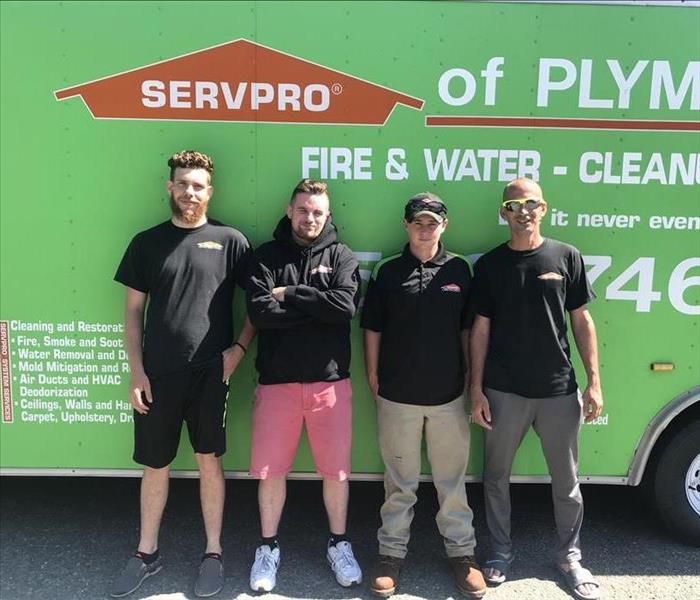 4 man crew from Plymouth, MA successfully takes on another Storm Event in South Hills, PA.
(from left to right: Ryan, Nick, Riley and Jay)
4 man crew from Plymouth, MA successfully takes on another Storm Event in South Hills, PA.
(from left to right: Ryan, Nick, Riley and Jay)
South Hills, PA Microburst
On Saturday June 21st, South Hills in PA got hit with a microburst that caused widespread water damage in several of the local homes. One of our crews had just returned from a storm event in Maryland when we heard the news, so the boys weren’t home for long before they packed up the SERVPRO vans again for yet another storm event road trip!
The Merriam-Webster Dictionary defines a microburst as “a violent short-lived localized downdraft that creates extreme wind shears at low altitudes and is usually associated with thunderstorms”. Microbursts are probably of the least acknowledged weather phenomena; however, they can be quite destructive. Wind speeds associated with microbursts can reach up to 100 mpg or higher and are usually less than or equal to 2.5 miles in diameter. Unlike tornadoes, microburst winds travel down and outward (and do not rotate). They usually occur during thunderstorms and come with little to no warning.
Most of the damage our crew encountered in the South Hills area was a result of sewage water flooding caused by the microburst. Sewage water is also commonly referred to as Category 3 water or black water. Black water is highly unsanitary, and is known to contain pathogenic, toxigenic, or other harmful agents. Black water damage restoration should always be handled by professionals (like us!).
In some cases, homes affected by water damage can be dried out and the materials (such as the carpets and pads) can be salvaged. When it comes to Category 3 water damages, these materials cannot be salvaged and must be torn out, bagged up, and properly disposed of. The home is then treated with anti-microbial agents to ensure harmful microorganisms are killed.
Click here to check out our Facebook, and see more content related to our Storm events, Water and Fire Damage Restoration, Mold Mitigation and more! If your home has suffered a disaster, call us today at (508) 746-9500
Ellicott City Flood
6/6/2018 (Permalink)
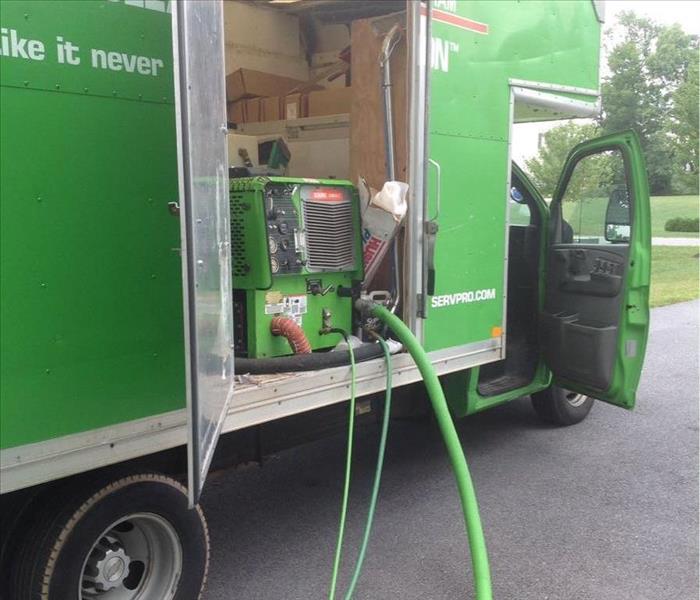 Vans loaded with equipment drive from Plymouth, MA to Ellicott City, MD.
Vans loaded with equipment drive from Plymouth, MA to Ellicott City, MD.
Ellicott City Flood, SERVPRO of Plymouth/Wareham springs to action
Several of our crew members here at SERVPRO of Plymouth/Wareham met at our warehouse on Sunday, June 3rd to pack up and head out to Ellicott City, MD to help with the flood damages once again. We responded to the first flood that happened July 30th, 2016, so our crew knew what to expect.
On Sunday, May 28th, 2018 Ellicott City was hit by another major flood. Nearly 8 inches of rain fall fell in a matter of hours (approximately two months’ worth of rain). Both the county executive and governor had declared the downtown area as in a state of emergency. Gas and electric had been shut off so power lines and gas mains could be assessed. An incident management team of 60 people provided assistance to the people of Howard County and Ellicott City. Those who were in need of emergency lodging were told of several local churches locations that were offering shelter. Howard County Executive Allan Kittleman said he was both devastated and heartbroken at a press conference that Sunday night.
Main Street in Ellicott City had been in a state of rebuilding since the 2016 flood. Governor Larry Hogan said at the Sunday press conference that “[The flood] is as bad or worse than the storm two years ago”. Howard County Executive Allan Kittleman said “… this is worse than July 30th, 2016”. Preliminary reports indicated that Sunday’s rainfall exceeded that of the flood two years ago. In 2016 Meteorologists dismissed the flood as a “1-in-1,000 year rain event”.
SERVPRO of Plymouth/Wareham is currently in Maryland servicing Ellicott City, Catonsville, Baltimore and Laurel. We are working our hardest to help these residents restore their homes back to their pre-storm conditions.
10 Tips to Prepare Your Home for Hurricane Season
5/23/2018 (Permalink)
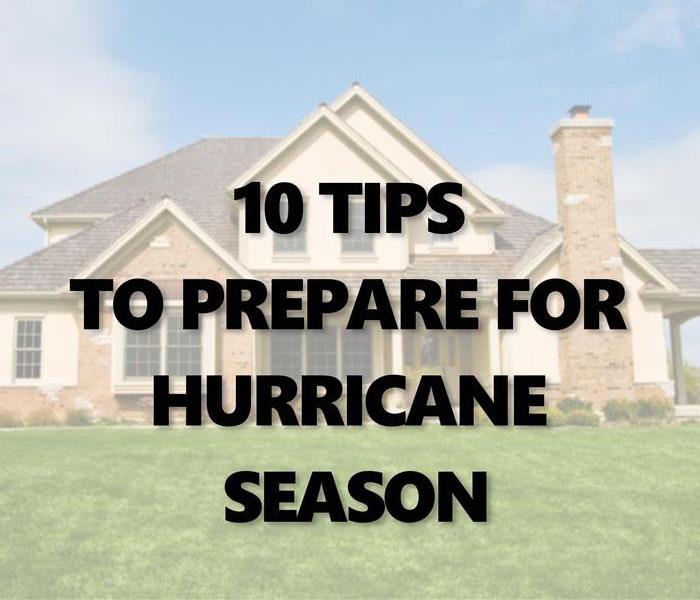 10 Tips To Prepare for Hurricane Season 2018
10 Tips To Prepare for Hurricane Season 2018
Preparing your Plymouth/Wareham Home for Hurricane Season
In a little over a week it will be hurricane season yet again. Last hurricane season was predicted to be “above-normal”, with major hurricanes like Hurricane Harvey and Hurricane Irma proving that prediction true. This year’s hurricane prediction hasn’t yet been announced by the Climate Prediction Center. However, if this season is anything like last season, we are hoping these tips on preparing your home for hurricane season will come in handy.
10 TIPS ON PREPARING YOUR HOME FOR HURRICANE SEASON
- Make sure your insurance policy will cover the full cost of rebuilding your home if it is destroyed during a storm.
- Consider getting flood insurance. Floods often follow a storm- and many homeowner insurance policies do not cover them.
- Take an inventory of your property, so that in the event of a storm you know exactly what you need to replace and how much it’s worth.
- Trim or remove damaged trees and limbs surrounding your home
- Retrofit your roof and seal all windows and doors so that they are secure. Consider adding roof straps if you have access to your roof via an attic
- Secure loose rain gutters and downspouts and make sure you clear any clogged areas to prevent any water damage
- Install a vertical garage door brace into your existing garage door so that it doesn’t blow in during a storm
- Make sure not to leave any furniture outside that could be picked up by strong winds and transformed into a projectile (such as patio furniture, grills, decorations etc.)
- Consider purchasing a portable generator for use during power outages
- Look into building a FEMA safe room for your property, click here for more info!
As football player Jack Youngblood once said, “Good luck is a residue of preparation”. If by chance you aren’t so lucky this hurricane season, give SERVPRO of Plymouth/Wareham a call. We can help restore your property back to it’s pre-storm condition. Give us a call at (508) 746-9500
It's Almost Hurricane Season!
5/22/2018 (Permalink)
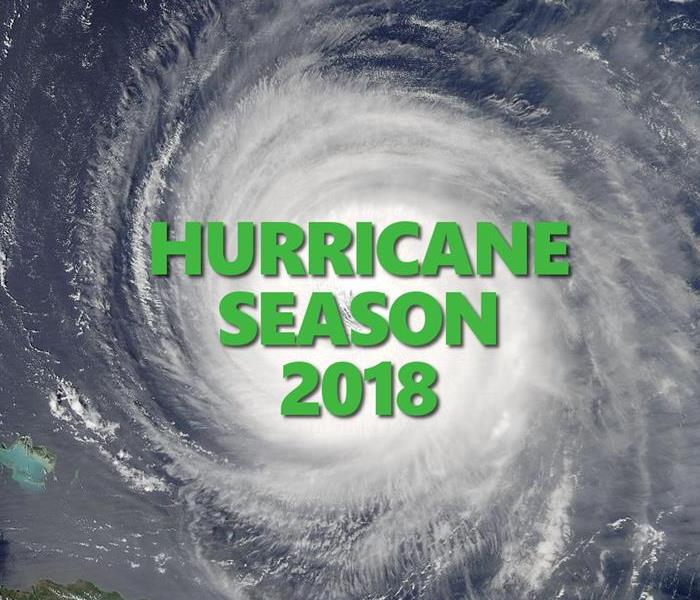 HURRICANE SEASON 2018 STARTS JUNE 1ST!
HURRICANE SEASON 2018 STARTS JUNE 1ST!
Hurricane Season 2018
Hurricane season is almost here. Atlantic hurricane season starts June 1st, with peak activity starting to happen in Mid-August. A hurricane is a tropical cyclone with high sustained wind speeds of at least 39 mph. There are 5 Categories of hurricanes which are based off those sustained wind speeds. Once a hurricane reaches 74-95mph, it is considered a Category 1. Here is a list of the 5 Categories of hurricanes and the sustained wind speeds associated with them.
- Category 1 (74-95 mph)
- Category 2 (96-110 mph)
- Category 3 (111-129 mph)
- Category 4 (130-156 mph)
- Category 5 (157mph or higher)
The Climate Prediction Center has 3 classifications for hurricane seasons based on the number of tropical storms and hurricanes. Here are the 3 classifications:
- Below-normal: between 4 and 9 tropical storms and between 2 to 4 hurricanes
- Near-normal: between 10 to 15 tropical storms and between 4 and 9 hurricanes
- Above-normal: between 12 and 28 tropical storms and between 7 and 15 hurricanes
Hurricane season 2017 was above-normal with 17 named storms, 10 of which became hurricanes (with six of those reaching major hurricane status). The Climate Prediction Center releases its hurricane season forecast at the end of May each year- so keep your eyes peeled!
No matter what the Climate Prediction Center forecasts this year, you should always be prepared during hurricane season. If disaster does strike- SERVPRO of Plymouth/Wareham responds immediately to your flood and storm damage emergencies. We have the storm damage restoration experience and specialized equipment to restore your home or business back to pre-storm condition, “Like it never even happened.”
When Storms or Floods hit the Plymouth/Wareham area, SERVPRO is ready!
5/8/2018 (Permalink)
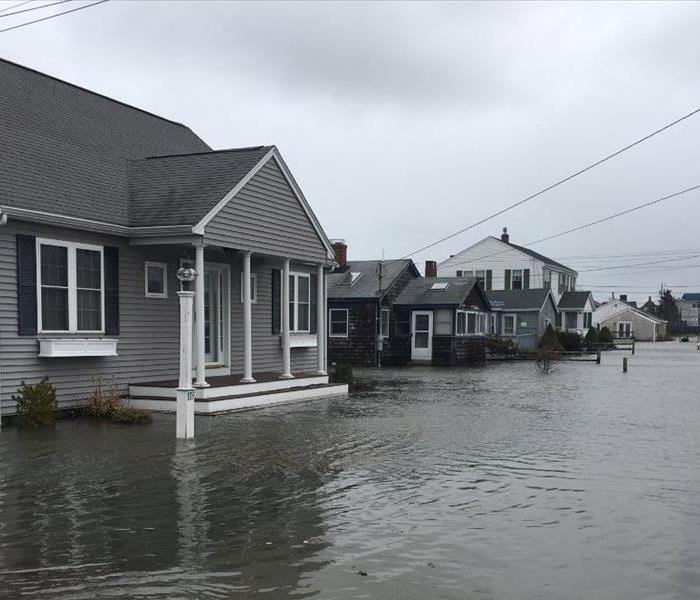 Our highly trained crews are ready to respond 24/7 to storm or flood damage in Plymouth/Wareham
Our highly trained crews are ready to respond 24/7 to storm or flood damage in Plymouth/Wareham
SERVPRO of Plymouth/Wareham specializes in storm and flood damage restoration. Our crews are highly trained and we use specialized equipment to restore your property to its pre-storm condition.
Faster Response
Since we are locally owned and operated, we are able to respond quicker with the right resources, which is extremely important. A fast response lessens the damage, limits further damage, and reduces the restoration cost.
Resources to Handle Floods and Storms
When a storm hits, we can scale our resources to handle a large storm or flooding disaster. We can access equipment and personnel from a network of 1,650 Franchises across the country and elite Disaster Recovery Teams that are strategically located throughout the United States.
Have Storm or Flood Damage? Call Us Today (508) 746-9500






 24/7 Emergency Service
24/7 Emergency Service















